The content of the article
Almost every child encounters snot, especially if he goes to kindergarten or visits other crowded places. In fact, there is nothing wrong with snot - this is how the body resists external pathogens and viruses. Discharge from the nose is designed to flush microorganisms from the mucous membrane. But not always snot can be harmless. If they change their color, become yellow, green and thick, then most likely a bacterial infection has joined, which needs to be treated more carefully. Unlike a viral pathogen, a bacterial runny nose needs antibiotic treatment. Today we’ll talk about the nature of green snot - how and why they appear, get acquainted with the main medical methods for their treatment, consider methods of home and professional nose washing, and also learn about folk methods for treating green snot.
Why do green snot appear
The color and consistency of nasal discharge changes only in two cases - if the bacteria multiply very quickly or if the mucus stagnates in the sinuses. Consider what can be the cause of the development of green snot in a child.
- Bacteria. Most often, the cause of green snot is in the bacteria that has entered the body. The disease can be caused by staphylococcus, streptococcus, Pseudomonas aeruginosa, pneumococcus, anaerobes, etc.
- Sinusitis. Green snot indicates sinus inflammation. Depending on which sinuses were affected, sinusitis, frontal sinusitis, ethmoiditis, sphenoiditis are distinguished.
- The consequences of SARS. Green snot is not always caused by bacteria. They may be the result of improper or inadequate treatment of the common cold in acute respiratory viral infections. If the sinuses are not cleared of mucus in a timely manner, the nose does not blow out, the mucus stagnates, the microbes in it multiply and the snot becomes thick and green.
- Otitis. Otitis can often be a source of green snot. The fact is that the communication between the nose and ear in children is very short and wide enough. This means that a disease of one organ leads to inflammation of the nearby. As a rule, in children, otitis media is a complication after sinusitis, rhinopharyngitis and sinusitis. However, there may be the opposite - otitis media can provoke the appearance of green snot.
- Allergy. There is still no consensus among doctors about the possibility of green snot in allergies. As you know, most often an allergic reaction is manifested precisely by the flow of mucus from the nose. And mucus is usually transparent and liquid. However, experienced allergists argue that this is not always the case. With severe allergies, when too much mucus is produced, the body does not have time to remove it, it stagnates and acquires a green color and a thick consistency. Therefore, with allergies, green snot also has a place to be.
- Immunity. If a child often and even constantly walks with green snot, most likely, his body simply cannot constantly resist external infections, especially if he encounters them every day in kindergarten. The reason for this is the weak immunity of the child.
It is very important to know the cause of the green snot. To do this, you need to analyze additional symptoms, but it is better to consult a doctor. If the child is sluggish, he has intoxication, the temperature is high - most likely, the baby was struck by a bacterial infection. If the child’s condition is good and nothing but green snot bothers him, then this is probably not a cured consequence of SARS.In this case, frequent washing is necessary, you can do without antibiotics. When the baby does not have additional symptoms of a cold - the throat is not red, there is no cough and fever, perhaps this is an allergic reaction. But guessing yourself is not worth it; it is better to contact a pediatric otolaryngologist so that he will give you the correct diagnosis.
Medication for green snot
It is very important not to self-medicate, but to go to the doctor, because it is he who can assess the real need for taking antibiotics - you can not use them just like that, for safety, in any case.
- Antibiotics. If you have a bacterial infection, antibiotics are prescribed. Remember, they are necessary only if the child has a fever, he is sluggish and his condition worsens. If the baby looks healthy, runs actively and has no temperature, you can get by with quality washes. In the fight against bacterial infection, antibiotics such as Augmentin, Ceftriaxone, Sumamed, Amoxiclav, etc. are used. The doctor must choose the dosage and the specific drug, depending on the age and individual characteristics of the child. Antibiotics are taken at regular intervals - this is very important.
- Antihistamines. Some mothers are surprised when they are prescribed drugs for allergies, when the baby does not have it. Firstly, the mother cannot always recognize an allergy, it can be masked by other symptoms. In this case, an antihistamine will be the main treatment. Secondly, even if the child does not have allergies, antihistamines will help relieve swelling of the mucosa, open nasal breathing. You can give the drug that is at home in the medicine cabinet - Lordes, Zirtek, Zodak, Diazolin, etc.
- Beneficial bacteria. If you are taking antibiotics, you must take care of the health of the intestinal microflora. Take beneficial bacteria to avoid dysbiosis. It can be Narine, Lactobacillus and Bifidobacterium, Hilak Forte, Linex, etc.
- Additional drugs. Be sure to use symptomatic treatment. If the child has a fever - use antipyretics, if the throat hurts - antiseptic sprays and lozenges, if the inflammation has passed to the lungs - take cough medicine. However, it is very important to recognize whether the lungs and trachea are inflamed or whether the child coughs only due to flowing mucus along the back of the throat. In the latter case, there is no need to treat a cough, it will go away with a runny nose.
With green snot, local treatment is necessary. For it to be effective, you need to know which drops and sprays to use.
How and how to treat the baby's nose with green snot
Many parents, trying to defeat a runny nose, drip and sprinkle to the child everything that is for the nose at hand. This is fundamentally wrong. Treatment for the common cold should be systemic. Here are a few groups of nasal drops to help you get rid of green snot. Processing and instillation of drugs must be done strictly in a certain order.
- Cleansing. First of all, the baby's nose needs to be cleaned of accumulated mucus. If this is not done, the medicine will simply be lost in a large number of secretions and will not reach the sinuses. If the baby can already blow his nose, ask him to blow his nose thoroughly, first one, and then the second nostril. Children over the age of two can drip into the nose a diluted Kalanchoe juice. After it, the baby will begin to sneeze actively, all the mucus will come out, this will achieve a high-quality cleansing of the nose and sinuses. If the baby is less than two years old, Kalanchoe should not be used, it is better to clean the nose with an aspirator. First you need to drop a drop of saline into each nostril, and when the snot softens, it will be easy to remove them with a special children's device.You can thin the snot with older children with the help of the drug Rinofluimucil - after it the mucus comes out much more efficiently.
- Vasoconstrictors. This is not a drug, but a drug that is very necessary in the treatment. Firstly, such sprays and drops will open nasal breathing and the baby will finally be able to breathe through the nose. Secondly, vasoconstrictors open the nasal passage so that medications can freely penetrate the inflamed sinuses - the therapeutic effect will be achieved much faster. Among children's vasoconstrictive drops and sprays, Naphthyzin, Nazol, Rinostop, Siolor, etc. can be noted.
- Antibacterial. And only after the nose has cleared, and the aisles have been opened for medicines, can antibacterial agents be used. This is a pure antibiotic that is used for topical treatment. Among effective medicines, Isofru, Polydex, Bioparox, Sofradex can be noted. The last drug is drops for the ears, but many doctors recommend it in the fight against purulent and green snot.
- Hormonal In some cases, children are prescribed hormonal drops. This is justified if breathing does not open after vasoconstrictor drugs, and a runny nose lasts a very long time. Such a cocktail is very effective - you need to mix the ampoule of saline, the ampoule of the hormonal drug Hydrocartisone and a bottle of antimicrobial drops for the eyes of Tsiprolet. Mix everything and drip into the baby’s nose twice a day, one drop in each nostril. Other effective hormonal drugs for topical treatment are Flixonase, Avamis, Budoster, Desrinitis, etc.
- Antimicrobial. Antiseptic drugs affect not only bacteria, but also the viral and fungal pathogens. Among the most popular are Protorgol, Miramistin, Furacilin, etc.
- Oil. In most cases, after a large number of medicinal drops, the nasal mucosa dries up, and the child feels serious discomfort. To avoid this, you can treat the baby's nose with oil drops - for example, Sinupret or Pinosol. These are herbal preparations that are very effective in controlling the common cold. By the way, Sinupred is very useful against various sinusitis, it can also be given to the child inside. If the nose is very dry, you can pipette a drop of sea buckthorn or almond oil into each nostril.
When choosing any drug, pay attention to the age at which the reception of a particular drug is permissible. Together with drops and sprays, external treatment of the nose can be carried out in the physiotherapist's office. Tube Quartz, Laser therapy, UHF heating, etc. are very effective.
Nasal lavage in the office at the ENT and at home
One of the most powerful and effective remedies against green snot is washing. And it’s much better to do them in the doctor’s office. Rinsing according to Proetz is the use of a vacuum unit that draws out all unnecessary and accumulated mucus from the sinuses. Flushing is safe even for babies. In fact, it is a quality and deep blowing. After drawing green mucus into the sinuses, antibacterial compounds are poured through the nostrils, which are pulled by the device from the other nostril. Thus, we get a high-quality sanitation of the inflamed sinuses. After the first rinse, the patient becomes much better. For a full recovery, 3-5 procedures are enough.
If there is no way to go to the doctor, washing can be done at home. For infants, washing involves frequent instillation of saline into the nostrils with a pipette. Older children can be taught to rinse their spouts using a kettle. Salted water, an antiseptic solution or a decoction of medicinal herbs is poured into it. The teapot nose is brought to one nostril, the baby tilts its head to the side so that water begins to pour out from the other nostril.Washing should be done until then, instead of purulent snot, transparent mucus begins to stand out. Lavage should be done as often as possible in order to disinfect inflamed sinuses in time. Salt solution is prepared in proportion - a teaspoon of salt per liter of water. Getting rid of green snot without rinsing the nose is quite difficult, but rinsing can completely suppress the disease, even without other medicines.
Home Remedies for Green Snot
Green snot is a sign of infection in the body and it is very dangerous to engage in self-treatment. The main emphasis should be on drug therapy and nasal lavage. It is very important to maintain sufficient humidity in the room so that the mucous membrane does not dry out. Be sure to maintain and strengthen the child’s immunity with proper nutrition, physical education, hardening, vitamins.
If the child does not have a temperature, you can and even need to walk in the fresh air - this helps to remove excess mucus, tempers the nasal passages and raises local immunity. During the walk, the flow from the nose intensifies, many mothers are afraid of this and stop walking with the baby until he is fully recovered. However, this is wrong. Just in fresh air, all the mucus is brought out, the mucous membrane begins to work more actively to wash off the pathogenic flora.
You can do a baby older than three years of inhalation - so that the child breathes through the nose, and therapeutic pairs treat the mucous membrane from the inside. Inhalations can be carried out in the old manner - with a basin, but it is much more effective to use a nebulizer. In no case do not use mother's milk to treat infants - this is an excellent food for bacteria, from this the runny nose will only intensify. Also, do not drip beets, carrots, onions, etc. into your nose. This is ineffective, and in relation to the child and unsafe - because the baby’s mucosa is very tender and sensitive, a burn can occur.
Older children (after 3-4 years) can be steamed legs. Warm your baby's feet together so that the baby is not afraid of hot water. Add mustard powder to the basin and put on warm socks immediately after the procedure. A rush of blood to the legs ensures its outflow from adenoids, which will give the child the opportunity to breathe through the nose. Remember, hot foot baths can not be done at a temperature or intoxication of the patient, wait until his health improves.
Snot is not always safe and harmless, as it seems at first glance. The trouble is that any course of the disease in children is accelerated several times. The inflammatory process is developing rapidly, it can lead to sinusitis and even meningitis. Moreover, infected mucus flows down the throat, spreading bacteria throughout the body. One of the common complications with green snot is otitis media. Therefore, one should not neglect green and thick snot, especially if the child is small. Be sure to show the baby to the doctor to be calm for his health!
Video: how to clean snot from a child’s nose

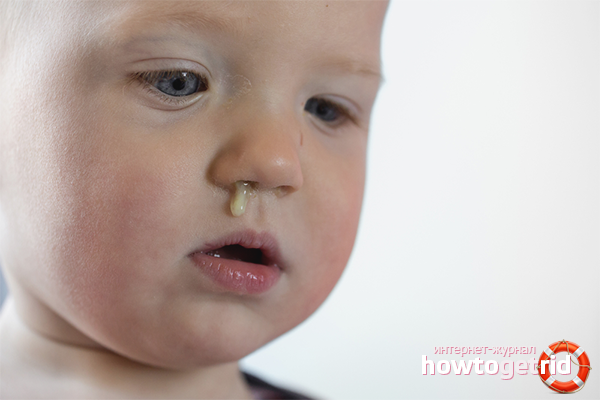

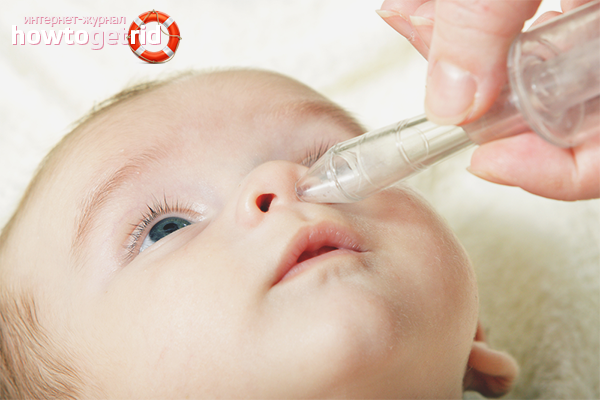
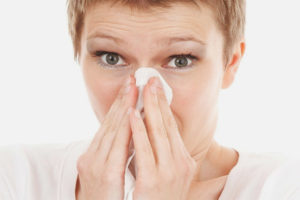



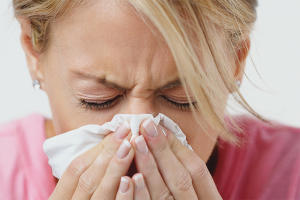
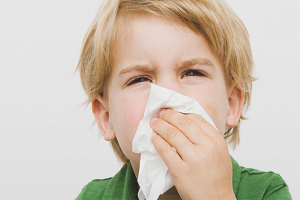
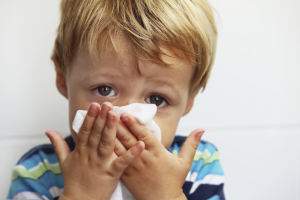
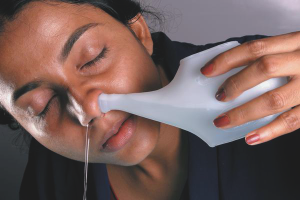
Submit
Thank you for the article. A lot of useful information. But the only thing, I’m very afraid of folk methods, is it really not scary to rinse your nose with a solution of celandine, especially for children, it can be dangerous. And some do just that. And I agree with Komarovsky, snot need to be treated on time. As I start to pry my nose, I wash it with Morenazal and Chamomile. I like.It contains chamomile oil, and it is known to be an excellent antiseptic, the most common I would say. Snot pass quickly, the disease does not drag on.